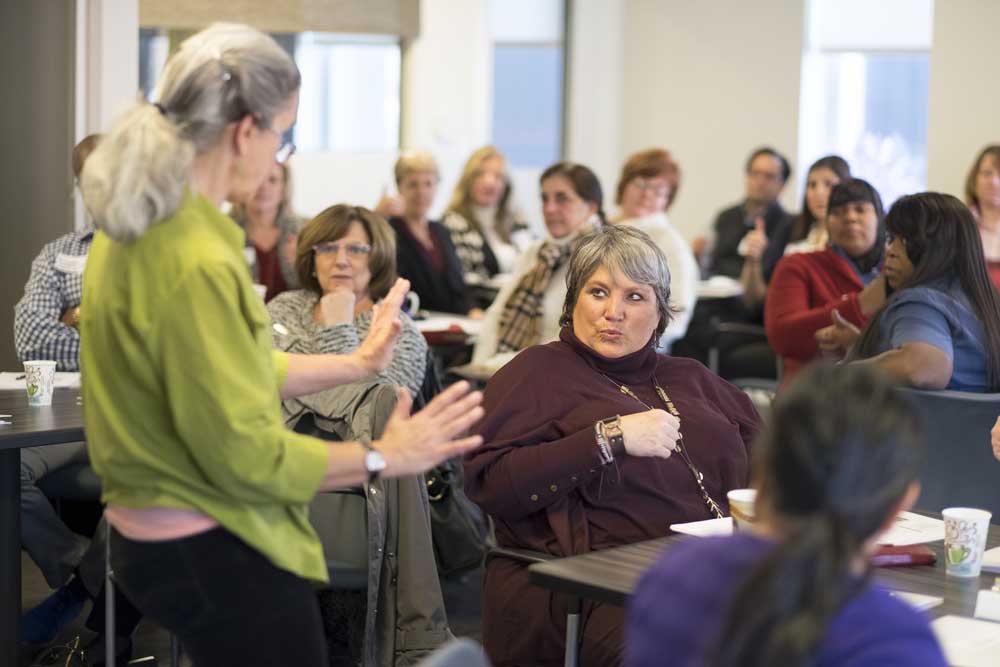How to talk to people with Alzheimer’s
Published 12:00 am Friday, February 12, 2016

- Ed Hille / Philadelphia Inquirer via Tribune News ServiceTeepa Snow, center, tries to elicit a reaction from Kim Smith, vice president of operations at Safe Senior Living, during a role-playing exercise as part of a seminar last month at Daylesford Crossing senior living community in Paoli, Pennsylvania.
PAOLI, Pa. — Expect to say “I’m sorry” a lot if you decide to try one of the trendier ways to communicate with people who have Alzheimer’s.
There was a time when caregivers tried orienting people with dementia to reality. That often feels like the natural thing to do. “No, Mom, I actually did tell you that. Like, five times.”
But at Daylesford Crossing, an assisted-living facility here, workers are more likely to just go with it if a resident has some strange ideas.
Let’s say Mom or Grandma is furiously accusing her neighbor of stealing something. Your first impulse may be to defend the neighbor, but that would just make things worse, said Kathleen Douglass, administrator and dementia specialist at Sage Senior Living, which opened Daylesford 18 months ago.
“I’m sorry that happened to you,” is a better answer, she said. Then you can show you’ve heard the emotion. “You seem really angry. I would be angry too if that happened.”
It’s time to give up thinking your truth and rationality will change the mind of someone with dementia. “She’s never going to be able to process that again,” Douglass said. “She’s in brain failure.”
Teepa Snow, originator of this “positive approach to care,” was in Daylesford last month to train about 50 staffers from Sage facilities and some family members in her principles. A Pittsburgh native who moved to North Carolina 45 years ago and who has a Southern accent to show for it, Snow demonstrated how brain damage from dementia affects behavior and offered hands-on tips to help caregivers fill in the gaps.
Her message: The more the person with dementia loses his brain, the more those around him have to use theirs.
Snow’s goal is to help caregivers make use of what’s still working in the brain and compensate for what isn’t. “Instead of focusing on the hole, we need to be looking at the doughnut,” she said.
Krista McKay, director of programs and services for the Alzheimer’s Association Delaware Valley chapter, said Snow is among a group of dementia experts who espouse a more person-centered philosophy — look at the person, not the disease. The approach, which the association has endorsed for years, has been slow to take off but is gaining traction.
“I would say that it’s taking root in a lot of ways, the care philosophy,” she said. “The issue at hand is whether it’s being applied.”
Older approaches, she said, make it a priority to feed residents three meals a day, dress them appropriately, and take care of their toileting needs. The new one, which requires more staff, places greater emphasis on personal relationships, reminiscence, and activities that draw out what a patient still cares about. “We have to go with that person along their journey as opposed to bringing them back,” she said.
Douglass added that the old approach relied more heavily on using medication to address problem behaviors. That’s less likely to be necessary when people’s needs are being met.
With the aid of pictures that showed how the brain atrophies during dementia, Snow, an occupational therapist, explained why these patients are often frightened or resistant.
Their hearing may be fine, but they can’t make sense of the words, so speaking more loudly only startles or annoys them.
Their visual field narrows considerably, especially when they are frightened. A 20-year-old’s peripheral vision can detect his moving fingers if he stretches his hands straight out to the side, but someone in the midstage of dementia can see only between two arms thrust straight forward. That means it’s easy for someone with dementia to think you’re sneaking up on him. If you stand right in front of him, you’re blocking his full visual field, which can feel threatening. It’s best to greet from a distance and then approach from the side.
Later in the course of the disease, the brain begins using visual messages from only one eye, throwing depth perception way off and increasing the risk of falling.
A high-energy presenter with a flair for the dramatic, Snow convincingly modeled different neurological deficits. She drew knowing looks from people in the audience who had no trouble thinking of specific residents she resembled. Most often, she was a shuffling, hunched, cantankerous woman who took offense quickly or did inappropriate things like fondling the shiny bald head of one worker and swearing prodigiously.
In one common scenario, she played a woman who pitched a fit when a worker tried to bring a new woman to her table in the cafeteria. Then Snow explained what this queen bee of the table might have been like. Before she got sick, she likely was an introvert who was always in control. Introverts, she said, are territorial.
The worker should have come to her before lunch and said, “I have a huge favor to ask of you.” She would describe how this new person needed a place to sit and needed to be with someone skillful. “What do you think?”
At that point, the queen bee likely would volunteer to accept the new resident, but, because of her memory problems, that’s not the end of it. Before the meal started, the worker would need to bring the new resident directly to the woman for the first introduction before actually showing her a chair.






